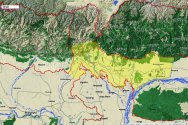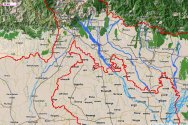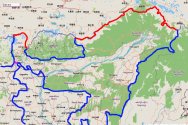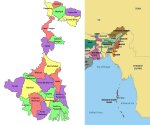A full scale invasion through the Himalayas is impossible, but if a Taiwan war did kick off they could pull another light infantry Galwan style invasion. In fact if it happened, I'm sure the Americans would push them into doing it.I've earlier already counted out India completely without anyone being able to refute it simply through geography.
The Himalayas are a natural fortress. 50k PLA troops there can hold out against a million Indians if needed. Its all valley choke points and impassable mountain ranges. Numerical superiority only works if you can spread out the units.
China is not so stupid that they will counter invade India and try to hold the Northern India region flatlands while US is full tilt doing its own attack, allowing Indians to bring their full army to actually fight.
Beijing will just sit on the chokepoints using an army of 50-100k, which is peanuts for the PLA, while droning Indian infrastructure.
Once US attack has been sufficiently dealt with, only then would China swing around and hit India both from Pakistan direction using heavy armor and from Himalayas direction using rapid light combat units.
It will be national suicide for India.
The only geographically credible path of invasion for India into China is to actually defeat Pakistan first, and then roll in through the Xinjiang Pakistan corridor. But that is not viable for obvious reasons.
Once again, I invite anyone who wants to refute the idea that the Himalayas do not support an Indian million man rush to speak up if they have any counterpoints. If you have a valid point I'd be interested in hearing it.
You are using an out of date browser. It may not display this or other websites correctly.
You should upgrade or use an alternative browser.
You should upgrade or use an alternative browser.
Lessons for China to learn from Ukraine conflict for Taiwan scenario
- Thread starter tphuang
- Start date
- Status
- Not open for further replies.
I'm not concerned about Indians at all. there is Pakistan for India to deal with. On top of that, the power difference between China and India is just so huge that WTC will have no problem dealing with India.
Here the lessons from Ukraine become fundamental.
Apart from general strategic errors Russia's failure in Ukraine is determined by Kremlin's choice to not pursue convenient geographical chokepoints which could allow it to gain or trade territory over time in a controlled fashion and retain control over escalation. They chose full frontal assault which is why they are in the current difficult position because there's no natural stopping point until AFU reaches border of Crimea so frontlines have to be sustained by force which consumes resources.
A good example of that was the capture of west bank of Dnipro which exposed valuable forces in a location convenient to AFU, caused attrition and ended in a humiliating retreat. If they instead stopped at Dnipro that situation would never happen while the more technically capable Russian force could present a credible threat across the river tying down AFU units without the fight.
But Russia didn't need to capture the west bank - it overreached and paid a heavy price for it. India has an equivalent of that territory that it must defend at all cost - the western states of Assam and others, and the disputed territory of Arunchal Pradesh that India controls.
National borders in red. Yellow area denotes the only land route to Arunchal Pradesh. Note the scale. The yellow area is approx. 250km in width and 50km in height.

I marked main rivers to emphasize the number of severe logistical disruptions that are possible within the yellow region. In particular note the narrow passage of approx 20x20km between Islampur and Bagdogra which lies entirely in district of Darjeeling and is separated by two rivers - an ideal chokepoint that can be achieved without physical control as Russian failure on the west bank demonstrated. Russians had to deal with two bridges. India will have to deal with... how many?

China has an advantage in long-range fires and aviation which will increase further in the coming decade. The only counter that India has against it is the land force which has to be supplied through that narrow and easily disrupted area. Once effectively isolated the tension with Bangladesh will increase.
If logistics in the yellow area is disrupted then Arunchal Pradesh is vulnerable and India has to fight in extremely constrained space between Bangladesh, Nepal, Bhutan and potentially Sikkim while China has direct access to contested area.
blue - boundary of neutral countries
red - boundary of Chinese entry zone
magenta - boundary of Indian entry zone
Magenta line denotes the only section of airspace through which Indian Air Force can enter the combat zone without violating neutrality of Bangladesh, Nepal or Bhutan. Compare with red. Also include the mountains to the north which limit radar horizon for ground-based SAM allowing China to take targeted shots without being exposed. This is what "geographical dominance" looks like in strategic, operational and tactical terms.

This is why India should not engage in conflict with China. Pakistan is not a problem on its own. The limited fighting in disputed territories seems to be BJP's attempt to increase control over formerly autonomous Muslim-majority Kashmir
If the area is politically destabilized India can lose all eastern states and end up surrounded on two sides. Strategically it can't allow China to link with Bangladesh. It is an existential threat from India's position as an aspiring power. And unfortunately the theater is decided by geography - just as I explained.
Here is my post from April of last year that provides more context:
Indian Military News, Reports, Data, etc.
France will not apply sanctions against India. After the Pokhran II nuclear tests the USA, UK and Germany applied sanctions against India, while France did not. Instead France assisted to integrate Israeli PGMs to IAF Mirage 2000s during the Kargil conflict. that was in 1998. now Euro-Atlantic...
www.sinodefenceforum.com
This is an important historical event that could play a role:
West Bengal was incorporated into India after Partition as Hindu majority state but the yellow area is more diverse ethnically and politically, especially if you exclude Hinduism as a broad category of beliefs and not a single uniform sect. It's important to remember than when West Bengal was separated from East Bengal (later East Pakistan and Bangladesh) by a national border India was ruled by National Congress from 1952 to 1996 when BJP became the largest party but it wasn't until 2014 that BJP achieved sufficient majority to rule on its own in practical terms. It's only been two terms.
West Bengal is not a BJP stronghold despite many areas supporting the party. It's a split.
Key districts for kinetic operations:
- Uttar Dinajpur - 3m pop, 50% Hindu/ 50%Muslim, 68% Bengali
- Darjeeling - 1,6m pop, 75% Hindu, 40% Nepali, 26% Bengali
- Kalimpong - 1m pop, 60% Hindu, 88% Nepali
- Jalpaiguiri - 2,4m pop, 82% Hindu, 66% Bengali
- Alipurduar - 1,5m pop, 80% Hindu, 50% Bengali
- Cooch Bihar - 2,8m pop, 75% Hindu/25% Muslim, 95% Bengali

Between Nepal and Bhutan lies the key state of Sikkim which is ethnically and politically separate from the surrounding Indian states (but 57% Hindu). An important factor is lack of direct access from Chinese territory to Indian territory that avoids Sikkim. This will require stimulating secession through diplomacy - which is plausible considering that historically Sikkim had a higher standard of living than India, and China could be seen as viable guarantor of that in the future.
Sikkim has 600k population. Arunchal Pradesh has 1,4m. The rest of the western states combined - excluding West Bengal - have 43m. Of those Assam which lies along Brahmaputra has 31m which means that majority of the total population is easily isolated and controlled.
Consequences of political destabiliation of eastern states:
- Arunchal Pradesh - 1,4m pop, 30% Christian, 29% Hindu, 26% folk
- Nagaland - 2m pop, 88% Christian
- Mizoram - 1m pop, 88% Christian
- Manipur - 2,8m pop, 41% Hindu, 41% Christian
- Tripura - 3,6m pop, 86% Hindu
- Meghalaya - 3,9m pop, 75% Christian
- Assam - 31m pop, 61% Hindu, 34% Muslim
China can contain escalation at this point because consequences of loss of those areas would be strategically significant and decisive. Likely Kashmir would be lost through backed insurgency as consequence as well.
Frankly, don't laugh off NK's Air Force. They were able to send in drones that SK couldn't detect and were able to scramble over 200 aircraft against SK.
North Korean Air Force has no capacity to meaningfully threaten anyone except its own pilots. It's a parade formation that continues its existence because of institutional inertia and likely because NK expects China to provide military aid e.g. J-7s or J-10As which makes sense from strategic perspective if both Korean states are involved in the conflict.
China should also try to use Russian military bases or operate PLARF brigades from Russia if Russians are willing.
Russia's neutrality is more useful to China than anything else Russia can offer. Just as Sweden's and Finland's neutrality was more advantageous to both NATO and Warsaw Pact. It provides a spatial and political buffer zone.
Russia has nukes and little else and in reality would be more of a burden than an asset considering the actual capabilities of Russian military which are being demonstrated in Ukraine. China doesn't need Russian mass land warfare and Russian air and naval capabilities (apart from nuclear submarines) are not relevant.
Biggest constraint for China would be its submarine force, it distinctly lacks a large nuclear submarine fleet compared to US and Russia.
It's a bit of a dilemma since before Taiwan is taken Chinese submarines are vulnerable due to shallow waters surrounding it's borders, yet they'll probably need a large submarine force to sufficiently contest US naval assets in the Pacific in AR scenario.
A sufficiently advanced submarine force can do area denial better than any warship or warplane can.
It's a bit of a dilemma since before Taiwan is taken Chinese submarines are vulnerable due to shallow waters surrounding it's borders, yet they'll probably need a large submarine force to sufficiently contest US naval assets in the Pacific in AR scenario.
A sufficiently advanced submarine force can do area denial better than any warship or warplane can.
Not true, if by the time B-21, NGAD & H-20 come around, PLA will have to concern itself with much longer strikes into CONUS. It will definitely be a plus if Russia's mass land allow PLARF in there or allow PLAAF aircraft to land in certain airports. Even just the ones around Khabarovsk or KNAAPO would make any mission to strike Elmendorf a lot easier.Russia has nukes and little else and in reality would be more of a burden than an asset considering the actual capabilities of Russian military which are being demonstrated in Ukraine. China doesn't need Russian mass land warfare and Russian air and naval capabilities (apart from nuclear submarines) are not relevant.
And PLARF doesn't have to go that far north of Heilongjiang for DF-26s to be able to strike Alaska.
80% of these live in tropical warm climates and have not industrialized enough to consume a tiny % of gas Russia used to be able to sell.
Case closed, Russia is economically fked and has no future. No point to keep debating this lol.
If you actually look at the revenue figures, you'll see that Russian oil revenues are far larger than gas revenues.
Your statement and analysis is not factually accurate




So there has been discussions about whether or not South Koreans will get involved. I think most of us would agree that the likelihood of that is really low when North Koreans have 5000 artillery pointed at them.
But 科罗廖夫 on weibo mentioned something worthwhile to think about today. The tactical ballistic missiles from PCL191 can hit pretty much everywhere in South Korea from Eastern tips of Shandong. Now I don't know the exact range of TBM, but I think 500 km would be a very conservative estimate. The soldier here says that the new MRLS has 7 times the strike range of the old one. Given that the old 300 mm rockets from PHL03 was said to have range of up to 70 to 130 km. That would point to range of 500 to 900 km depending on the warhead size and such. The lower end would put most of Korea in the range.
The higher end would put the important Sasebo naval base in range from Jiangsu & Shandong and put Okinawa in range from Zhejiang. 900 km would be equivalent to the recent DF-15 variants. DF-15 diameter is 1/3 greater, which means circumference is almost probably 80% more. With a smaller warhead and improved fuel and flying profile, 900 km may not be that impossible.
Using PCL191 would take some of the load off DF-17 and PLARF in the initial strikes.
View attachment 105674View attachment 105675
View attachment 105676View attachment 105677
So there has been discussions about whether or not South Koreans will get involved. I think most of us would agree that the likelihood of that is really low when North Koreans have 5000 artillery pointed at them.
But 科罗廖夫 on weibo mentioned something worthwhile to think about today. The tactical ballistic missiles from PCL191 can hit pretty much everywhere in South Korea from Eastern tips of Shandong. Now I don't know the exact range of TBM, but I think 500 km would be a very conservative estimate. The soldier here says that the new MRLS has 7 times the strike range of the old one. Given that the old 300 mm rockets from PHL03 was said to have range of up to 70 to 130 km. That would point to range of 500 to 900 km depending on the warhead size and such. The lower end would put most of Korea in the range.
The higher end would put the important Sasebo naval base in range from Jiangsu & Shandong and put Okinawa in range from Zhejiang. 900 km would be equivalent to the recent DF-15 variants. DF-15 diameter is 1/3 greater, which means circumference is almost probably 80% more. With a smaller warhead and improved fuel and flying profile, 900 km may not be that impossible.
Using PCL191 would take some of the load off DF-17 and PLARF in the initial strikes.
Personally I think the PCL191/PHL16 shouldn't be overthought too much -- it's a system that's going to be in every theater eventually.
More heavier hitting, longer ranged strike/fires systems is always a good thing, and would be useful in all of the PLA's five theater commands.
The ability of PCL191/PHL-16 to replace/supplement the existing SRBMs is something that has been established, and is definitely not unique to South Korea.
Personally I also think we should wait to get confirmation that the tactical ballistic missile of the system is actually in PLA service.
There are also some sources claiming that the 300mm rockets for both the PHL-03 and PHL-16 have a range of 100-150 kilometers instead of 70-130 kilometers - I am guessing that those are the improved version. The interviewed soldier did not specify whether the 300mm rockets are of the initial version or the improved version.View attachment 105674View attachment 105675
View attachment 105676View attachment 105677
So there has been discussions about whether or not South Koreans will get involved. I think most of us would agree that the likelihood of that is really low when North Koreans have 5000 artillery pointed at them.
But 科罗廖夫 on weibo mentioned something worthwhile to think about today. The tactical ballistic missiles from PCL191 can hit pretty much everywhere in South Korea from Eastern tips of Shandong. Now I don't know the exact range of TBM, but I think 500 km would be a very conservative estimate. The soldier here says that the new MRLS has 7 times the strike range of the old one. Given that the old 300 mm rockets from PHL03 was said to have range of up to 70 to 130 km. That would point to range of 500 to 900 km depending on the warhead size and such. The lower end would put most of Korea in the range.
The higher end would put the important Sasebo naval base in range from Jiangsu & Shandong and put Okinawa in range from Zhejiang. 900 km would be equivalent to the recent DF-15 variants. DF-15 diameter is 1/3 greater, which means circumference is almost probably 80% more. With a smaller warhead and improved fuel and flying profile, 900 km may not be that impossible.
Using PCL191 would take some of the load off DF-17 and PLARF in the initial strikes.
Therefore, if the TBM has 7 times the range of the older MLRS, then:
1. 70km x 7 = 490km
2. 100km x 7 = 700km
3. 130km x 7 = 910km
4. 150km x 7 = 1050km
The TBM that have ranges of 910 and/or 1050 kilometers are sufficient to cover the entire Korean peninsula + Sasebo comfortably from the Shandong peninsular.
There is also a marginal possibility that Kure can also be covered by the 1050 kilometer-ranged TBM, however the launchers would have to be stationed right at the tip of the Shandong peninsula. So, not exactly ideal.
Also, this 科罗廖夫 guy also mentioned about a 610mm rocket with a range of 400 kilometers. Is the PLAGF known to operate MLRS of this caliber?
On the other hand, perhaps this could be another viable reason that Shandong is under the Northern Theater Command (NTC) instead of the Eastern Theater Command (ETC) of the PLA - The NTC is specifically designated to deal with the Korean peninsula and the mainland Japan. Meanwhile, the ETC is meant to deal with Taiwan and the Ryukyu Islands.
I think 1050 is pushing it a little bit. The 750 mm wide SRBM would have 4 times the volume as 370mm rockets. I don't think it's crazy to think it might have twice the range. Which would put both Sasebo in range of 71st GA and Okinawa in range of 72nd GA. Of course, they are so close to mainland, that PLA can launch attack at these bases from wide variety of bases and method. I'm simply discussing SRBM because that seems to be a role where PLAGF is taking over with PCL191 as DF-15s get retired. According to patch, TBMs from PCL191s all have anti-shipping variant also. He does not think it makes a lot of sense for them to hit Okinawa with PCL191s even though they probably do have the range to do so. We will see. I'm sure more photos will come out over time.There are also some sources claiming that the 300mm rockets for both the PHL-03 and PHL-16 have a range of 100-150 kilometers instead of 70-130 kilometers - I am guessing that those are the improved version. The interviewed soldier did not specify whether the 300mm rockets are of the initial version or the improved version.
Therefore, if the TBM has 7 times the range of the older MLRS, then:
1. 70km x 7 = 490km
2. 100km x 7 = 700km
3. 130km x 7 = 910km
4. 150km x 7 = 1050km
The TBM that have ranges of 910 and/or 1050 kilometers are sufficient to cover the entire Korean peninsula + Sasebo comfortably from the Shandong peninsular.
There is also a marginal possibility that Kure can also be covered by the 1050 kilometer-ranged TBM, however the launchers would have to be stationed right at the tip of the Shandong peninsula. So, not exactly ideal.
Also, this 科罗廖夫 guy also mentioned about a 610mm rocket with a range of 400 kilometers. Is the PLAGF known to operate MLRS of this caliber?
On the other hand, perhaps this could be another viable reason that Shandong is under the Northern Theater Command (NTC) instead of the Eastern Theater Command (ETC) of the PLA - The NTC is specifically designated to deal with the Korean peninsula and the mainland Japan. Meanwhile, the ETC is meant to deal with Taiwan and the Ryukyu Islands.
- Status
- Not open for further replies.
